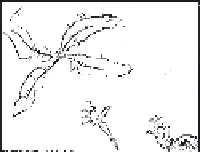Graphics Reference
In-Depth Information
detail, and the act of smoothing it out with water was pleasantly tactile. It was a triceratops
and I had found a suitably lively pose suggestive of a beast in motion. Being about ten inches
in length, it was perfect for animation. The other piece was a larger than life size human hand,
again caught in some action. Years later when I saw Trnka's masterpiece
The Hand
(which mixed
an exquisite puppet with a large clay and sometimes real hand) I had a sense of déjà vu, as I
had unknowingly built a similar story around this hand. Like the triceratops, there was a week's
work put into the texture, suggesting veins and i ngernails, and trying to i nd the right pose.
The night they both went into the kiln together, I could hardly sleep, desperate to see the hours
of work come to fruition. Come to dust actually: as the exploded pieces lay ruined so did any
thoughts of ever working with clay again. I gave up frighteningly easily.
It's a shame, as I enjoy the transformations possible with claymation, and the rawness of it, but
in this instance I would lack the patience for the sculpting. In the lengthy period of resculpting
and smoothing out I would probably lose my sense of movement and performance, so it
amazes to see so much performance out of Wallace and Gromit, and in such lively i lms as
Will Vinton's tour de force
The Great Cognito
, in which a single head and shoulders transforms
into many of the major i gures from World War II. In many respects I like shooting ten or more
seconds a day as I can tangibly experience the performance. I'm not sure I could at one or two
seconds a day. How claymation animators ever time a gag over such an extended period is
beyond me.
Apart from the labour-intensive work involved, I would miss the texture of rich and lavish
costumes and wrinkles in the skin, although looking at Wallace and Gromit this never
seems to be a problem, as the sets are so lavishly textured and tactile. The contradiction
between all the steel and rivets and bricks of West Wallaby Street and the smoothness of
Gromit's skin and Wallace's chunky pullovers just shouldn't work, seeming to belong in
dif erent i lms, but it does. Maybe it's this contrast that gives them their charm. The other
thing I would miss through working with clay is a certain elegance of the sculpting and the
movement, but then again Wallace and Gromit are hardly static. I respond to the i nesse
and delicacy that i nely engineered puppets give, especially in long legs and arms and i ne
i ngers. Claymation is particularly good for overemphasising the facial expressions and
squashing and stretching, and I'm not sure that's how I think as an animator. I'm probably
far tighter and controlled, which is not always a good thing. I don't always try for realistic
movement, and love a l orid performance, but I'm uncomfortable with stretch and squash
in a physical puppet as I feel it destroys the credibility I've tried to set up. I would rather
suggest the weight and inertia through the performance than through distorting a
puppet.
Most claymation, probably owing to the sheer time constraints and labour, is shot in double
frames, which works for most people, but personally, I love single frame, and would be happier
shooting i fty frames for a second. That would give me the detail and complexity of movement
I would like to achieve, but it would be pretty impossible to shoot the required
amount each day. I i nd that when I'm totally absorbed in a shot, I get into a
quick routine of move-check-click-move-check-click. There are some actions
where i fty frames a second would be a waste of ef ort, but then there are many
movements, like Ratty playing the piano in
The Wind in the Willows
, that would
benei t from this number of frames. As it was, there were just not enough frames
available to reproduce the exact movement, but then the suggested movement


Search WWH ::

Custom Search